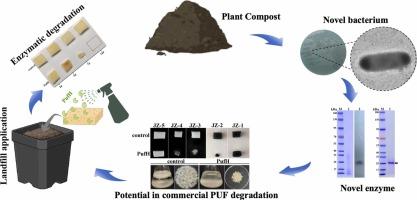PufH:一种很有前途的生物催化剂,用于聚氨酯泡沫废物的回收和生物修复
IF 11.3
1区 环境科学与生态学
Q1 ENGINEERING, ENVIRONMENTAL
引用次数: 0
摘要
随着聚氨酯泡沫塑料(PUF)的广泛使用,PUF垃圾的处理提出了重大的环境挑战。基于酶的PUF废物回收和生物修复被认为是一种可持续的解决方案,但仍然缺乏合格的酶。本文分离到了一种新的puf降解菌——葛根芽孢杆菌sp. YX66。从该菌株中鉴定出一种高效的聚氨酯泡沫水解酶(PufH),其序列与先前报道的PU解聚合酶的相似性小于23%。产物分析和分子对接表明,PufH特异性靶向PUF软段内的酯键。PufH对各种商用聚酯型PUF表现出显著的活性,在30°C下48小时内达到90%的最大解聚率,显著优于其他PUF解聚酶的性能。此外,PufH在4 ~ 20℃的温度下仍保持相当大的活性,使其能够在环境温度下14天内有效地解聚土壤中的PUF废物。这些发现强调了PufH作为一种有前途的生物催化剂在PUF废物的回收和生物修复中的潜力。本文章由计算机程序翻译,如有差异,请以英文原文为准。

PufH: A promising biocatalyst for the recycling and bioremediation of polyurethane foam waste
As the extensive use of polyurethane foam (PUF), the disposal of PUF waste poses significant environmental challenges. Enzyme-based recycling and bioremediation of PUF waste is regarded as a sustainable solution but still suffers from the lack of qualified enzymes. Here, a novel PUF-degrading bacterium, Pueribacillus sp. YX66, was isolated. An efficient polyurethane foam hydrolase (PufH), was identified from this strain, which showed less than 23 % sequence similarity to the previously reported PU depolymerases. Product analysis and molecular docking suggested that PufH specifically targeted the ester bonds within the soft segment of PUF. PufH exhibited remarkable activity against various commercial polyester-type PUFs, achieving a maximum depolymerization rate of 90 % within 48 h at 30 °C, significantly surpassing the performance of other PUF depolymerases. Moreover, PufH retained considerable activity at the temperature of 4–20 °C, enabling it to efficiently depolymerize PUF waste in soil within 14 days under ambient temperature. These findings underscore the potential of PufH as a promising biocatalyst in the recycling and bioremediation of PUF waste.
求助全文
通过发布文献求助,成功后即可免费获取论文全文。
去求助
来源期刊

Journal of Hazardous Materials
工程技术-工程:环境
CiteScore
25.40
自引率
5.90%
发文量
3059
审稿时长
58 days
期刊介绍:
The Journal of Hazardous Materials serves as a global platform for promoting cutting-edge research in the field of Environmental Science and Engineering. Our publication features a wide range of articles, including full-length research papers, review articles, and perspectives, with the aim of enhancing our understanding of the dangers and risks associated with various materials concerning public health and the environment. It is important to note that the term "environmental contaminants" refers specifically to substances that pose hazardous effects through contamination, while excluding those that do not have such impacts on the environment or human health. Moreover, we emphasize the distinction between wastes and hazardous materials in order to provide further clarity on the scope of the journal. We have a keen interest in exploring specific compounds and microbial agents that have adverse effects on the environment.
 求助内容:
求助内容: 应助结果提醒方式:
应助结果提醒方式:


